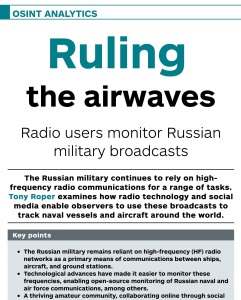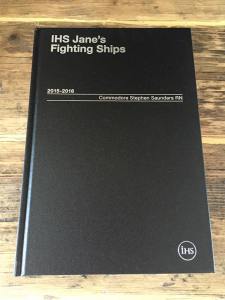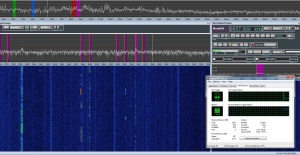With the rebuild of my shack complete I’ve been able to start testing out all my radios, new connections etc.
A whole bundle of new cables from Mini-Circuits arrived last of all and have helped tidy up the back of the radio 19″ rack considerably. I’ve previously installed quite a few Mini-Circuits components, including 0.141″ diameter Hand-Flex interconnect cables, and so it was more of these that I opted for. The bonus with these cables is that they are hand formable meaning you can shape and bend them into pretty much any area that you want to. The 141 series (which I use) are capable of a 8mm bend radius, whilst the thinner 086 series can be bent to 6mm.

Being able to manipulate the cables certainly helps in tight spaces, and when you don’t want them to hang down
Previously I used hand-made cables with RG58U coax, but in order to have a 19″ rack that can slide out from under the desk, the cables needed to be longer than actually required. Because of this the cables would drop down into all the others attached to the PC and in some cases cause a little interference. With the Hand-Flex cables I’ve been able to use the same length of coax to allow me to move out the rack, but be able to bend them up and out of the way of the PC cables.
They’re also very good for the radios on the rack, being able to bend them and hold in place around the radios and other cables. They are near lossless too with a quoted insertion loss of 0.01 dB in the HF band to 0.55 dB at 18GHz. I normally run tests of the Mini-Circuit components when I receive them and find that the figures quoted are near spot on. I highly recommend these cables if you’re looking to upgrade your systems, and are available from the Mini-Circuits website, along with lots of other goodies that will tempt you.

Measurement of insertion loss of the Mini-Circuits ZF3RSC-542B-S+ Power Splitter/Combiner I also purchased as part of my plans for satellite communication monitoring. This is connected to the AirSpy SDR and takes feeds from two SatCom connections (currently deactivated) and a WinRadio AX-71C Discone Antenna. Mini-Circuits quote an insertion loss of around 19.5dB at 130 MHz which is confirmed here with a signal generated at -20dB being less than 1dB out at -40.48dB when passed through the combiner.
The radio setup now includes two new SDR’s – an AirSpy HF+ and a standard AirSpy with the HF+ replacing the Enablia TitanPro. I’ve also reinstated my WinRadio G31DDC which had been in storage for a year or so. I really do like the TitanPro, and have put it into storage for the time being. The recording capabilities in particular are great with it being able to select 40 frequencies at once spread over numerous bandwidths, but I have had issues with the power supply – one being it caused interference. I attempted to make one of my own but it has a 6v(+/-1v)/2.5 Amp current requirement and no matter how many different methods of building my own supply using a 12v feed downgrading to 5, 6 or 7 volts, it just wouldn’t work in a stable manner. In the end it was easier to remove it and slot the G31DDC back in its place.
As it is, I’d forgotten how good the G31DDC is and I don’t really feel like I’m missing much thanks to the ability to use the other SDR’s with SDR Console V3 and it’s SDR Analyser.

The three 19″ racking units from Penn Elcom, along with all the shelves, have been very useful and certainly makes things easier when it comes to changing radios and connections over. I can just disconnect a few things and slide the whole unit out. I also obtained a 19″ Project box from them which I used as my main 12v switch unit. This is connected to two regulated desktop power supplies that act as master switches.
Although the SDR Console website page for the Analyser states it isn’t available yet, this is incorrect and it is downloaded with the latest version of the main programme.
If you’re a current user of V2 or have been in the past then you won’t notice much difference. You can have up to 24 parallel demodulators operating within the SDR’s bandwidth that you have chosen, all of which can run independent of each other in receive and record. You can also run each demodulator through a decoder such as MultiPSK independently and decode these in parallel with each other. This capability has taken that step towards those of the TitanPro, especially when being used with the Elad FDM-S2 that can provide a Maximum DDC bandwidth of 6144kHz’s.
Unfortunately, whilst you can schedule recordings of IQ data, you still can’t do this for individual channel recordings. This is a real shame as it would be a fantastic addition to the capabilities of SDR Console.
Getting back to the analyser though this does, in theory, cancel out the lack of channel recording scheduling.
When you record IQ data it is saved as WAV files, split into multiple ones depending on how long a recording you make . All of these files can be individually played back through the incorporated SDR Console player but even better is the use of the File Analyser.
With this you get a visual “image” of the complete recording, whereby after opening the analyser you get it to combine all the files into one XML file. For the image below I used the FDM-S2 with a selected bandwith of 768kHz centred on 4425kHz, hoping to catch calls to Russian Naval base Severomorsk in CW(RJD99) from ships operating in the region. I set the scheduler up to record from 0000z to 0700z which worked perfectly, giving me 78 files totalling 78GB – obviously, the bigger the bandwidth, the larger the total file size.
After clicking on New in the analyser and browsing to the relevant folder the WAV files are saved in, the analyser finds the first one and gives this as an option to open – it automatically adds the remaining WAV files and starts the process. This can take quite some time to extract, around 45 minutes for the example shown. But you only need to do this once because once it has finished you can save it as an XML file and open it at any time – in this case it was a 28MB XML file.
A note here – do not then delete the WAV files as the analyser still needs them.
As you can see, I was successful in locating calls to RJD99, and I have highlighted some of the others that I took a look at – this is just a screenshot of two hours out of the seven recorded.
All you then need to do is find any signal of interest, and after clicking on select and start in the top ribbon, click on the signal. This will then start playing the file from that location in the main SDR Console window. You don’t need to stay on that frequency, you can use the Console as if you were listening live and move around the frequency range you dictated in the bandwidth of the recording.
And, as it is basically a live screen you can do additional things such as record and use decoding software.
When using the Analyser I run this through a separate PC meaning SDR Console itself can carry on working on the main radio control PC. This is also handy if you’re away but have time to go through the IQ data using a laptop. Just copy over the original WAV files to a portable hard drive/memory stick and carry on as described above.
There are numerous other functions available for you to use with the main part of SDR Console, some I still haven’t had the chance to play with completely. I’m still exploring things such as the Signal History function which can store up to 48 hours of data. Here you can export data in CSV format to third-party programs such as QtiPlot. Signal history can also be used within the Analyser
This is useful as it can give you a quick overview into single frequency use, signal strengths, fading and such like. Definitely something I need to spend more time on.
It’s been a long time coming, but Version 3 of SDR Console has been well worth the wait.
















 Talking of having things published in
Talking of having things published in 

 He lived quite an amazing life during those 50 years, too much for me to cover here, but luckily a book was written about him by Richard Brooks, published in 1997. The book is still available today, easily found on Amazon for instance, and is titled Fred T. Jane – An eccentric Visionary (From Ironclad Ships To 21st Century Information Solutions) – and it is a great read.
He lived quite an amazing life during those 50 years, too much for me to cover here, but luckily a book was written about him by Richard Brooks, published in 1997. The book is still available today, easily found on Amazon for instance, and is titled Fred T. Jane – An eccentric Visionary (From Ironclad Ships To 21st Century Information Solutions) – and it is a great read.














 I’ve recently had another article published in
I’ve recently had another article published in